vue 之 vuex
Vuex
什么是Vuex?
官方说法:Vuex 是一个专为 Vue.js应用程序开发的状态管理模式。它采用集中式存储管理应用的所有组件的状态,并以相应的规则保证状态以一种可预测的方式发生变化。
个人理解:Vuex是用来管理组件之间通信的一个插件
为什么要用Vuex?
我们知道组件之间是独立的,组件之间想要实现通信,我目前知道的就只有props选项,但这也仅限于父组件和子组件之间的通信。如果兄弟组件之间想要实现通信呢?嗯..,方法应该有。抛开怎么实现的问题,试想一下,当做中大型项目时,面对一大堆组件之间的通信,还有一大堆的逻辑代码,会不会很抓狂??那为何不把组件之间共享的数据给“拎”出来,在一定的规则下管理这些数据呢? 这就是Vuex的基本思想了。
Vuex有什么特性?
怎么使用Vuex?
引入Vuex.js文件
创建实例:

<!DOCTYPE html>
<html lang="en">
<head>
<meta charset="UTF-8">
<meta name="viewport" content="width=device-width, initial-scale=1.0">
<meta http-equiv="X-UA-Compatible" content="ie=edge">
<title>Document</title>
</head>
<script src="./js/vuex.js"></script>
<script src="./js/vue2.0.js"></script>
<body>
<div id="app"> </div>
</body>
<script>
Vue.use(Vuex);//在创建Vue实例之前
var myStore = new Vuex.Store({
state:{
//存放组件之间共享的数据
name:"jjk"
},
mutations:{
//显式的更改state里的数据
},
getters:{
//获取数据的方法
},
actions:{
//
}
});
new Vue({
el:"#app",
data:{
name:"dk"
},
store:myStore,
mounted:function(){
console.log(this)//控制台
}
})
</script>
</html>

先解释上面代码的意思:
new Vuex.Store({}) 表示创建一个Vuex实例,通常情况下,他需要注入到Vue实例里. Store是Vuex的一个核心方法,字面上理解为“仓库”的意思。Vuex Store是响应式的,当Vue组件从store中读取状态(state选项)时,若store中的状态发生更新时,他会及时的响应给其他的组件(类似双向数据绑定) 而且不能直接改变store的状态,改变状态的唯一方法就是,显式地提交更改(mutations选项)
他有4个核心选项:state mutations getters actions (下文会仔细分析)
这是上面代码:
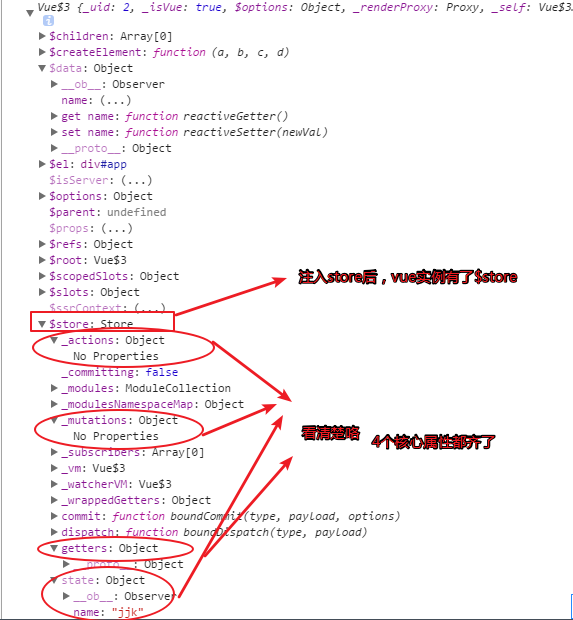
那如何获取到state的数据呢?
一般会在组件的计算属性(computed)获取state的数据(因为,计算属性会监控数据变化,一旦发生改变就会响应)

<!DOCTYPE html>
<html lang="en">
<head>
<meta charset="UTF-8">
<meta name="viewport" content="width=device-width, initial-scale=1.0">
<meta http-equiv="X-UA-Compatible" content="ie=edge">
<title>Document</title>
</head>
<script src="./js/vuex.js"></script>
<script src="./js/vue2.0.js"></script>
<body>
<div id="app">
<hello></hello>
</div>
</body>
<script>
Vue.use(Vuex);
var myStore = new Vuex.Store({
state:{
//存放组件之间共享的数据
name:"jjk"
},
mutations:{
//显式的更改state里的数据
},
getters:{
//过滤state数据
},
actions:{
//
}
}); Vue.component('hello',{
template:"<p>{{name}}</p>",
computed: {
name:function(){
return this.$store.state.name
}
},
mounted:function(){
console.log(this)
}
})
new Vue({
el:"#app",
data:{
name:"dk"
},
store:myStore,
mounted:function(){
console.log(this)
}
})
</script>
</html>

在·chrome中显示:
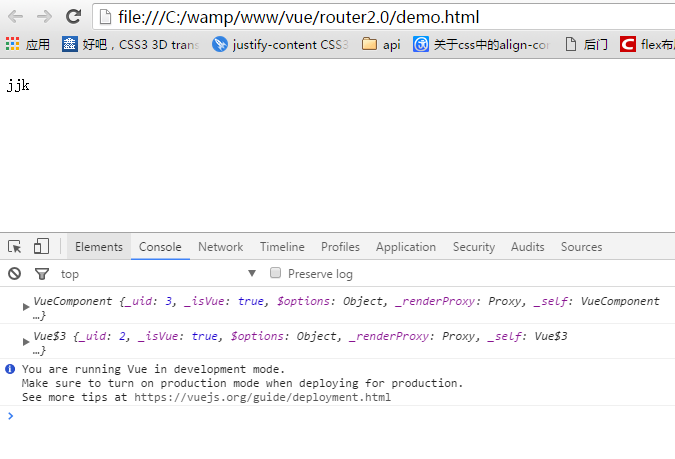
state:用来存放组件之间共享的数据。他跟组件的data选项类似,只不过data选项是用来存放组件的私有数据。
getters:有时候,我们需要对state的数据进行筛选,过滤。这些操作都是在组件的计算属性进行的。如果多个组件需要用到筛选后的数据,那我们就必须到处重复写该计算属性函数;或者将其提取到一个公共的工具函数中,并将公共函数多处导入 - 两者都不太理想。如果把数据筛选完在传到计算属性里就不用那么麻烦了,getters就是干这个的,你可以把getters看成是store的计算属性。getters下的函数接收接收state作为第一个参数。那么,组件是如何获取经过getters过滤的数据呢? 过滤的数据会存放到$store.getters对象中。具体看一个例子:

<!DOCTYPE html>
<html lang="en">
<head>
<meta charset="UTF-8">
<meta name="viewport" content="width=device-width, initial-scale=1.0">
<meta http-equiv="X-UA-Compatible" content="ie=edge">
<title>Document</title>
</head>
<script src="./js/vuex.js"></script>
<script src="./js/vue2.0.js"></script>
<body>
<div id="app">
<hello></hello>
</div>
</body>
<script>
Vue.use(Vuex);
var myStore = new Vuex.Store({
state:{
//存放组件之间共享的数据
name:"jjk",
age:18
},
mutations:{
//显式的更改state里的数据
},
getters:{
getAge:function(state){
return state.age;
}
},
actions:{
//
}
}); Vue.component('hello',{
template:"<p>姓名:{{name}} 年龄:{{age}}</p>",
computed: {
name:function(){
return this.$store.state.name
},
age:function(){
return this.$store.getters.getAge
}
},
mounted:function(){
console.log(this)
}
})
new Vue({
el:"#app",
data:{
name:"dk"
},
store:myStore,
mounted:function(){
console.log(this)
}
})
</script>
</html>

在chrome中显示:
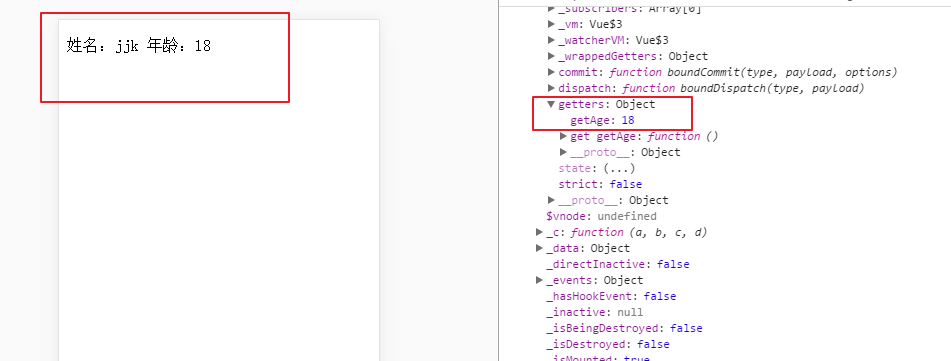

<!DOCTYPE html>
<html lang="en">
<head>
<meta charset="UTF-8">
<meta name="viewport" content="width=device-width, initial-scale=1.0">
<meta http-equiv="X-UA-Compatible" content="ie=edge">
<title>Document</title>
</head>
<script src="./js/vuex.js"></script>
<script src="./js/vue2.0.js"></script>
<body>
<div id="app">
<hello></hello>
</div>
</body>
<script>
Vue.use(Vuex);
var myStore = new Vuex.Store({
state:{
//存放组件之间共享的数据
name:"jjk",
age:18,
num:1
},
mutations:{
//显式的更改state里的数据
change:function(state,a){
// state.num++;
console.log(state.num += a); }
},
getters:{
getAge:function(state){
return state.age;
}
},
actions:{
//
}
}); Vue.component('hello',{
template:"<p @click='changeNum'>姓名:{{name}} 年龄:{{age}} 次数:{{num}}</p>",
computed: {
name:function(){
return this.$store.state.name
},
age:function(){
return this.$store.getters.getAge
},
num:function(){
return this.$store.state.num
}
},
mounted:function(){
console.log(this)
},
methods: {
changeNum: function(){
//在组件里提交
// this.num++;
this.$store.commit('change',10)
}
},
data:function(){
return {
// num:5
}
}
})
new Vue({
el:"#app",
data:{
name:"dk"
},
store:myStore,
mounted:function(){
console.log(this)
}
})
</script>
</html>

当点击p标签前,chrome中显示:
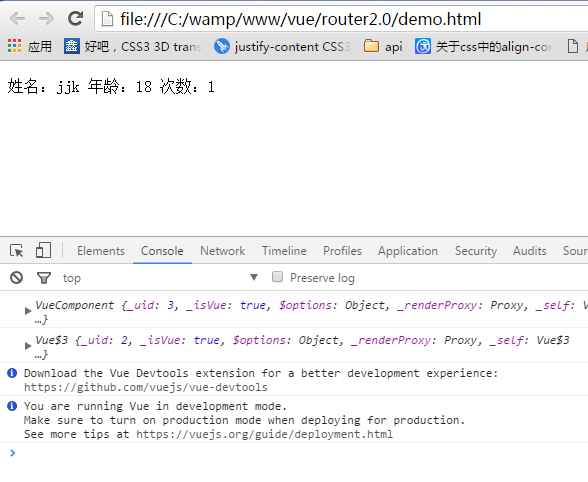
点击p标签后:
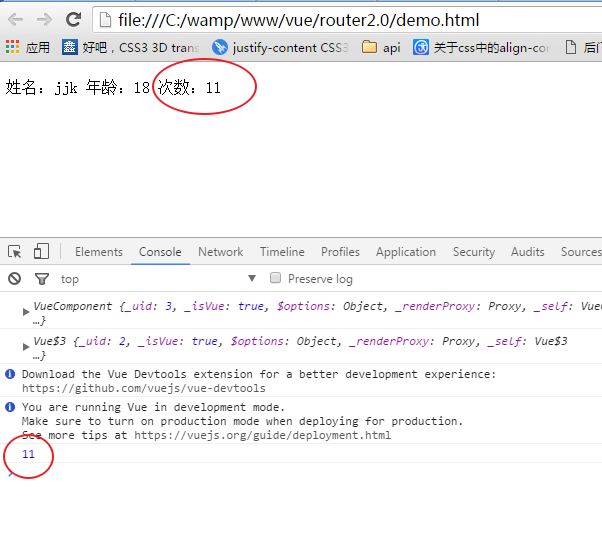
可以看出:更改state的数据并显示在组件中,有几个步骤:1. 在mutations选项里,注册函数 函数里面装逻辑代码。2.在组件里,this.$store.commit('change',payload) 注意:提交的函数名要一一对应 3.触发函数,state就会相应更改 4.在组件的计算属性里 this.$store.state 获取你想要得到的数据
actions:既然mutations只能处理同步函数,我大js全靠‘异步回调’吃饭,怎么能没有异步,于是actions出现了...
actions和mutations的区别
1.Actions 提交的是 mutations,而不是直接变更状态。也就是说,actions会通过mutations,让mutations帮他提交数据的变更。
2.Action 可以包含任意异步操作。ajax、setTimeout、setInterval不在话下
再来看一下实例:

<!DOCTYPE html>
<html lang="en">
<head>
<meta charset="UTF-8">
<meta name="viewport" content="width=device-width, initial-scale=1.0">
<meta http-equiv="X-UA-Compatible" content="ie=edge">
<title>Document</title>
</head>
<script src="./js/vuex.js"></script>
<script src="./js/vue2.0.js"></script>
<body>
<div id="app">
<hello></hello>
</div>
</body>
<script>
Vue.use(Vuex);
var myStore = new Vuex.Store({
state:{
//存放组件之间共享的数据
name:"jjk",
age:18,
num:1
},
mutations:{
//显式的更改state里的数据
change:function(state,a){
// state.num++;
console.log(state.num += a); },
changeAsync:function(state,a){
console.log(state.num +=a);
}
},
getters:{
getAge:function(state){
return state.age;
}
},
actions:{
//设置延时
add:function(context,value){
setTimeout(function(){
//提交事件
context.commit('changeAsync',value);
},1000) }
}
}); Vue.component('hello',{
template:`
<div>
<p @click='changeNum'>姓名:{{name}} 年龄:{{age}} 次数:{{num}}</p>
<button @click='changeNumAnsyc'>change</button>
</div>`,
computed: {
name:function(){
return this.$store.state.name
},
age:function(){
return this.$store.getters.getAge
},
num:function(){
return this.$store.state.num
}
},
mounted:function(){
console.log(this)
},
methods: {
changeNum: function(){
//在组件里提交
// this.num++;
this.$store.commit('change',10)
},
//在组件里派发事件 当点击按钮时,changeNumAnsyc触发-->actions里的add函数被触发-->mutations里的changeAsync函数触发
changeNumAnsyc:function(){
this.$store.dispatch('add', 5);
}
},
data:function(){
return {
// num:5
}
}
})
new Vue({
el:"#app",
data:{
name:"dk"
},
store:myStore,
mounted:function(){
console.log(this)
}
})
</script>
</html>

点击按钮一秒后,chrome中显示:
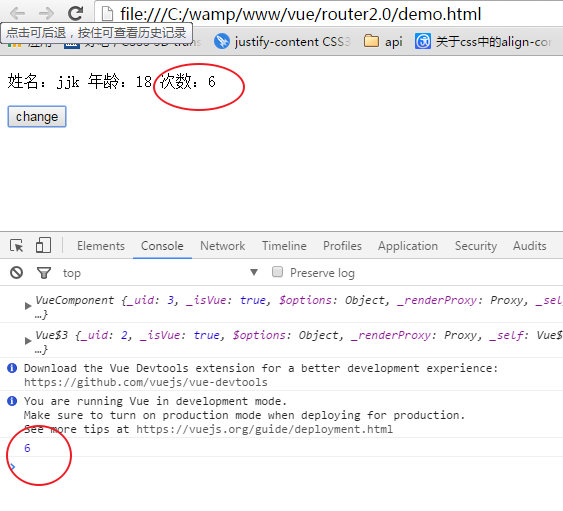
先整明白 context dispatch是什么东西:
context:context是与 store 实例具有相同方法和属性的对象。可以通过context.state和context.getters来获取 state 和 getters。
dispatch:翻译为‘派发、派遣’的意思,触发事件时,dispatch就会通知actions(跟commit一样一样的)参数跟commit也是一样的。
action的大体流程:
1.在actions选项里添加函数(异步)并提交到对应的函数(在mutation选项里)中 context.commit('changeAsync',value);

actions:{
add:function(context,value){
setTimeout(function(){
context.commit('changeAsync',value);
},1000)
}
}

2. 在组件里: changeNumAnsyc:function(){this.$store.dispatch('add', 5);} 将dispatch“指向”actions选项里的函数
3. 在mutations选项里,要有对应的函数 changeAsync:function(state,a){console.log(state.num +=a);}
总结:
各个类型的 API各司其职,mutation 只管存,你给我(dispatch)我就存;action只管中间处理,处理完我就给你,你怎么存我不管;Getter 我只管取,我不改的。 action放在了 methods 里面,说明我们应该把它当成函数来用(讲道理,钩子函数也应该可以的) mutation是写在store里面的,这说明,它就是个半成品,中间量,我们不应该在外面去操作它。getter写在了 computed 里面,这说明虽然 getter我们写的是函数,但是我们应该把它当成计算属性来用。
vue 之 vuex的更多相关文章
- Vue 2.0 + Vue Router + Vuex
用 Vue.js 2.x 与相配套的 Vue Router.Vuex 搭建了一个最基本的后台管理系统的骨架. 当然先要安装 node.js(包括了 npm).vue-cli 项目结构如图所示: ass ...
- Vue之Vuex
一.什么是vuex Vuex 是一个专为 Vue.js 应用程序开发的状态管理模式.它采用集中式存储管理应用的所有组件的状态,并以相应的规则保证状态以一种可预测的方式发生变化.简单来说就是一个数据统一 ...
- requirejs、vue、vuex、vue-route的结合使用,您认为可行吗?
在五一节之前和一网友讨论前端技术时,对方提到vue.vue-route如果配合requirejs应用.当时的我没有想得很明白,也没能这位网友一个准确的回复,但我许诺于他五一研究后给他一个回复.本是一天 ...
- Vue中Vuex的详解与使用(简洁易懂的入门小实例)
怎么安装 Vuex 我就不介绍了,官网上有 就是 npm install xxx 之类的.(其实就是懒~~~哈哈) 那么现在就开始正文部分了 众所周知 Vuex 是什么呢?是用来干嘛的呢? Vuex ...
- vue:vuex中mapState、mapGetters、mapActions辅助函数及Module的使用
一.普通store中使用mapState.mapGetters辅助函数: 在src目录下建立store文件夹: index.js如下: import Vue from 'vue'; import ...
- vue+vue-router+vuex实战
shopping vue + vue-router + vuex实现电商网站 效果展示 install 下载代码: git clone https://github.com/chenchangyuan ...
- 15.vue动画& vuex
Vue.config.productionTip = false; ==是否显示提示信息== ==import/export== export xxx 必须跟跟对象或者和定义一起 对象: export ...
- Vue、Vuex+Cookie 实现自动登陆 。
概述 1.自动登陆实现思路. 2.vuex + cookie 多标签页状态保持. 自动登陆的需求: 1.登陆时勾选自动登陆,退出登陆或登陆到期后再次登陆后自动填写表单(记住密码)或访问登陆页自动登陆. ...
- 深入浅出的webpack4构建工具--webpack4+vue+route+vuex项目构建(十七)
阅读目录 一:vue传值方式有哪些? 二:理解使用Vuex 三:webpack4+vue+route+vuex 项目架构 回到顶部 一:vue传值方式有哪些? 在vue项目开发过程中,经常会使用组件来 ...
- vue:vuex详解
一.什么是Vuex? https://vuex.vuejs.org/zh-cn 官方说法:Vuex 是一个专为 Vue.js应用程序开发的状态管理模式.它采用集中式存储管理应用的所有组件的状态,并以相 ...
随机推荐
- go语言的源码文件的分类及含义
Go源码文件:名称以.go为后缀,内容以Go语言代码组织的文件 多个Go源码文件是需要用代码包组织起来的 源码文件分为三类:命令源码文件.库源码文件(go语言程序) 测试源码文件(辅助源码文件) 命令 ...
- MVC分层思想、SSM编程架构
1 MVC 和 SSM
- Ubuntu重启关机命令使用
如果你想保持当前用户的登录而且使用root用户执行命令 可以输入:su root,输入密码 可以运行,shutdown 命令 重启命令: 1.reboot 2.shutdown -r now 立刻重启 ...
- poj3420 Quad Tiling
传送门 题目大意 问讲一个大小为4*n的棋盘用无数1*2的骨牌不重叠覆盖有多少种方案. 分析 我们考虑可以将长为n的棋盘分为两块,一个大小为n-i,另一个大小为i,而为了避免对于不同的i构造出相同的情 ...
- CF609E Minimum spanning tree for each edge
原来觉得是一个LCT,感觉自己瞬间傻掉…… 考虑到先做一个最小生成树求出做最小生成树的代价$ans$,顺便标记一下树边和非树边,把边按照输入$id$排序回去之后扫,如果扫到一条树边,那么此时的答案就是 ...
- 给大家推荐 用 hBuilder编写代码非常好用
截图 可以试哈
- python 根据字典中的key,value进行排序
#coding=utf-8 import requests,json,collections,base64,datetime def sort(datas): data=json.dumps(data ...
- DjVu转PDF
作者:马健邮箱:stronghorse_mj@hotmail.com发布:2009.09.22更新:2012.06.11针对PdfToy的新进展,更新了相关内容. 1 引言2 理论3 实现 3. ...
- c语言判断是否是utf8字符串,计算字符个数
#include <stdio.h> #include <string.h> #include <stdlib.h> /********************** ...
- UC浏览器体验
1.用户界面: 有两个页面,一个展示网页应用-可添加自己喜欢的网页应用,另一个用来搜索,有推荐的常用的网址,有UC头条,页面下有设置,整体布局常规 2.短期刺激: 没有特别花哨的地方:个人感觉比较实用 ...
